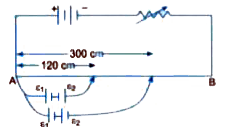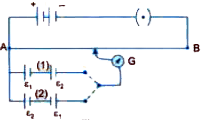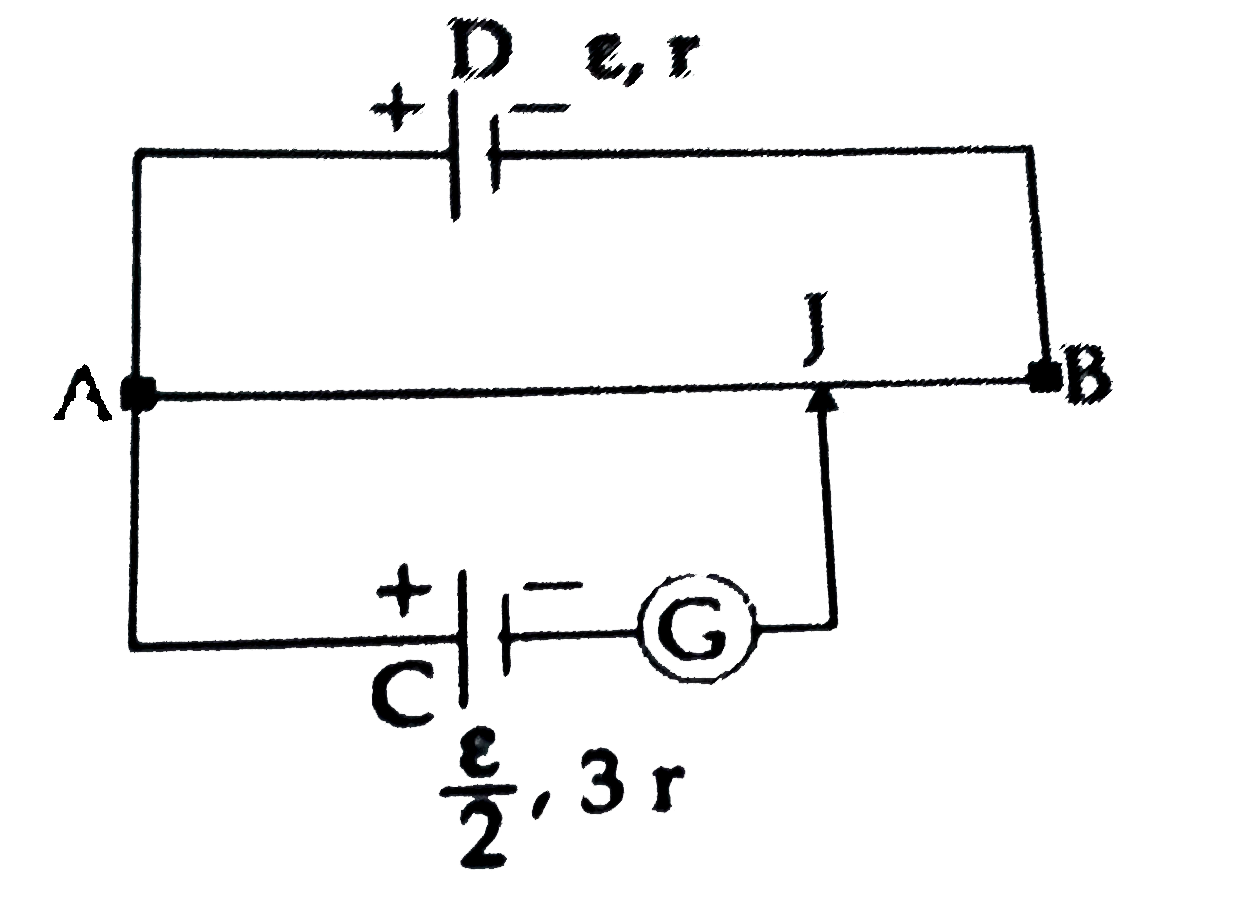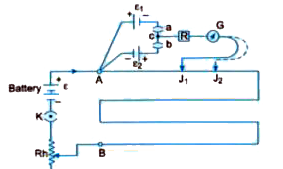In the Fig., a long uniform potentiometer wire AB is having a constant potential gradient along its length. The null points for the two primary cells of emf and connected in the manner shown are obtained at a distance of 120 cm and 300 cm from the end A. Find and (ii) position of null point for the cell . How is the sensitivity of a potentiometer increased ?

(i) If the constant potential gradient be k volt/cm then as per question
....(i)
....(ii)
(ii) If for the cell the null point be at a distance of 1 from end A, then
Dividing (i) by (iii), we have
The sensitivity of a potentiometer can be increased by (i) increasing the length of the potentiometer wire, and (ii) introducing a high resistance in series of potentiometer.
Topper's Solved these Questions
- CURRENT ELECTRICITY BOOK - U-LIKE SERIESCHAPTER - CURRENT ELECTRICITY EXERCISE - LONG ANSWER QUESTIONS - II
8 Videos
- CURRENT ELECTRICITY BOOK - U-LIKE SERIESCHAPTER - CURRENT ELECTRICITY EXERCISE - SELF ASSESSMENT TEST (SECTION A (MULTIPLE CHOICE QUESTIONS))
6 Videos
- CURRENT ELECTRICITY BOOK - U-LIKE SERIESCHAPTER - CURRENT ELECTRICITY EXERCISE - SHORT ANSWER QUESTIONS
42 Videos
- CBSE SAMPLE QUESTION PAPER 2019-20 (SOLVED)BOOK - U-LIKE SERIESCHAPTER - CBSE SAMPLE QUESTION PAPER 2019-20 (SOLVED)EXERCISE - SECTION D
6 Videos
- DUAL NATURE OF RADIATION AND MATTERBOOK - U-LIKE SERIESCHAPTER - DUAL NATURE OF RADIATION AND MATTEREXERCISE - SELF ASSESSMENT TEST SECTION-C (VERY SHORT ANSWER QUESTIONS)
3 Videos
Similar Questions
In the figure a long uniform potentiometer wire AB is having a constant potential gradient along its length. The null points for the two primary cells of emfs ε1 and ε2 connected in the manner shown are obtained at a distance of 120 cm and 300 cm from the end A. Find (i) ε1/ε2 and (ii) position of null point for the cell ε1.
How is the sensitivity of a potentiometer increased ?

View SolutionIn the figure a long uniform potentiometer wire AB is having a constant potential gradient along its length. The null points for the two primary cells of emfs ε1 and ε2 connected in the manner shown are obtained at a distance of 120 cm and 300 cm from the end A. Find (i) ε1/ε2 and (ii) position of null point for the cell ε1.
How is the sensitivity of a potentiometer increased ?

View Solution
Knowledge Check
ε - caprolactum is the monomer of
ANylon - 6,6BNylon -6CTeryleneD66 carbon atomIf the value of potential gradient on potentiometer wire is decreased, then the new null point will be obtained at
Alower lengthBhigher lengthCsame lengthDnothing can be said
A circuit using a potentiometer and battery of negligible internal resistance is set up as shown in Fig. to develop a constant potential gradient along the wire AB. Two cells of emfs ε1 and ε2 are connected in series as shown in combinations (1) and (2). The balance points are obtained respectively at 400 cm and 240 cm from the point A. Find (i) ε1ε2 , (ii) balancing length for the cell ε1 only .

View SolutionA potentiometer wire is 100 cm long and a constant potential difference is maintained across it. Two cells of emfs ε1andε2 are connected in series first to support one another and then in opposition. The balance points were obtaind at 60 cm and 12 cm from the same end of the wire in the two cases. find the ratio of the emfs.
View SolutionA potentiometer wire AB having length L and resistance 12 r is joined to a cell D of emf ε/2 and internal resistance 3r is connected. The length AJ at which the galvanometer as shown in fig. Shows no deflection is :

View SolutionA potentiometer wire AB having length L and resistance 12 r is joined to a cell D of emf ε/2 and internal resistance 3r is connected. The length AJ at which the galvanometer as shown in fig. Shows no deflection is :

View SolutionA potentiometer wire AB having length L and resistance 12 r is joined to a cell D of emf ε/2 and internal resistance 3r is connected. The length AJ at which the galvanometer as shown in fig. Shows no deflection is :

View SolutionA student uses the circuit diagram of a potentiometer as shown in Fig.

(a) For a steady current I passing through the potentiometer wire, he gets a null point for the cell ε1and not for ε2 . Give reason for this observation and suggest how this difficulty can be resolved.
(b) What is the function of resistance R used in the circuit? How will the change in its value affect the null point ?
(c ) How can the sensitivity of the potentiometer be increased?
View Solution
